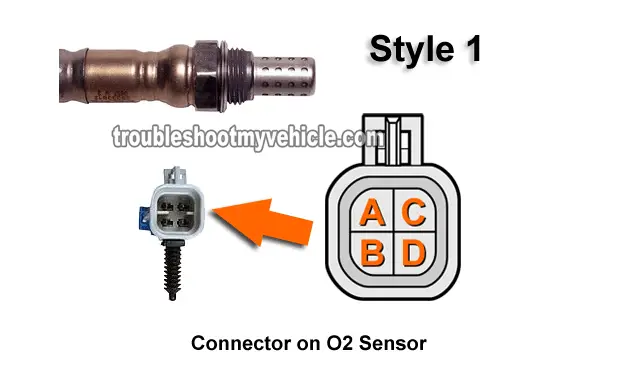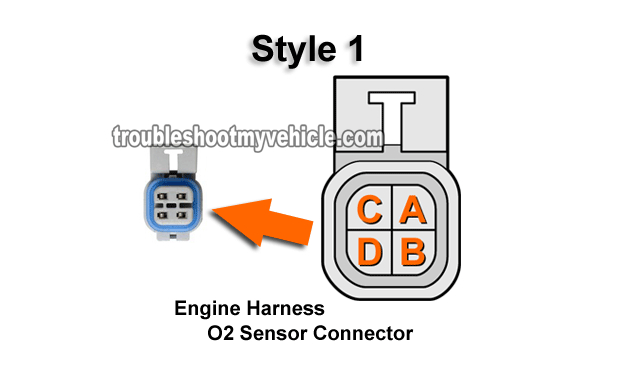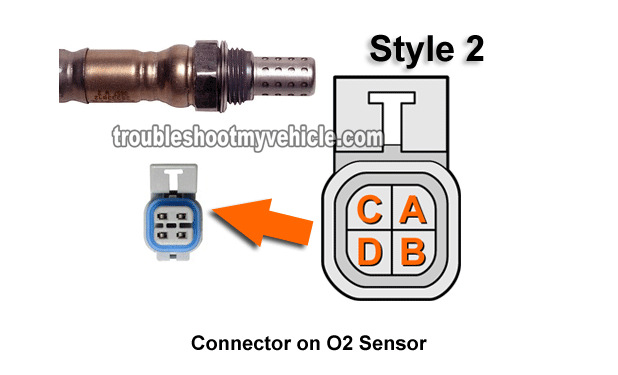
Testing the post-catalytic converter oxygen (O2) sensors, to see if they are causing the P0141 or P0161 to light up your check engine light (CEL) on your instrument cluster is not hard to do.
With the testing instructions in this tutorial, I'll show you how to test them and find out if they are good or bad.
So, if you have one of the following diagnostic trouble codes:
- P0141: HO2S Heater Performance Bank 1 Sensor 2.
- P0161: HO2S Heater Performance Bank 2 Sensor 2.
And your GM 4.8L, 5.3L, or 6.0L pickup (or SUV) is between the years 2003 and 2005, this is the article for you. If this tutorial doesn't cover your specific vehicle, take a look at the index of tutorials here: O2 Sensor Tutorial Index.
Contents of this tutorial:
NOTE: The downstream oxygen (O2) sensors are also known as: post catalytic converter oxygen sensors or rear oxygen sensors and I'll be using all of these terms throughout this tutorial.
Before we jump into troubleshooting P0141 and/or P0161 on your GM vehicle, I highly recommend that you take a look at the following oxygen sensor Test primer (if you haven't already):
This article answers a lot of the most common questions like:
- Symptoms Of A Bad oxygen sensor heater element.
- Where are the O2 sensors located?
- What tools do I need?
- What does the heater inside the oxygen sensor Do?
Circuit Descriptions Of The Downstream Oxygen Sensors
I'm sure this isn't news to you that each post catalytic converter oxygen (O2) sensor has 4 wires in its connector.
Knowing which wires to test (because we can actually test the heater element inside the downstream oxygen sensor) becomes a must to get to the bottom of the P0141 and P0161 trouble codes
Here's what you need to know: Each of the four wires is identified by a letter. These four letters used are: A, B, C, and D.
Of the four wires, we need to worry only about the wire identified by the letter D and letter D. These two are the ones that feed power and Ground to the heater element within the downstream oxygen sensor.
Now, in case you didn't know, you'll find these letters embossed on the oxygen sensor connector too. Below, in the charts, you'll find a color description of these wires and their specific job.
NOTE 1: In the chance that the color of the wires below don't match what's on the downstream oxygen sensor on your specific vehicle, the info in this tutorial still applies. Why? Because you can use the letters (A, B, C, and D) embossed on the connectors to identify the circuits.
NOTE 2: There are two different styles of rear heated oxygen sensors that are used on the GM vehicles covered by this tutorial. To be a bit more specific, the difference is in the oxygen sensor's connectors. The illustrations that I'm using cover both styles of connectors and although the letters (of the circuits) are in different places, the circuit description that each letter represents is the same.
| O2 Bank 1 Sensor 2 Circuits (4.8L, 5.3L, 6.0L) | ||
|---|---|---|
| Pin | Wire Color | Description |
| A | Tan w/ White stripe | HO2S Low Signal |
| A <-> | Tan | HO2S Low Signal (Canada built) |
| B | Purple w/ White stripe | HO2S High Signal |
| C | Black | Heater Element Ground (Chassis Ground) |
| D | Pink | Heater Element 12 Volts (O2 sensor fuse) |
| O2 Bank 2 Sensor 1 Circuits (4.8L, 5.3L, 6.0L) | ||
|---|---|---|
| Pin | Wire Color | Description |
| A | Tan | HO2S Low Signal |
| B | Purple | HO2S High Signal |
| C | Black | Heater Element Ground (Chassis Ground) |
| D | Pink | Heater Element 12 Volts (O2 sensor fuse) |
Where To Buy The Oxygen Sensor And Save Some $
You could buy the downstream oxygen sensor at your local auto parts store but you'll end up paying quite a bit for it (I'm sure you've already called and priced the O2 sensor) or you could buy it online and save a few bucks.
Disclosure: As an Amazon Associate, I earn from qualifying purchases. If my tutorials help you, using these links is an easy way to support the site at no extra cost to you. Thank you!
Not sure if the O2 sensor fits your vehicle. No worries? Once you get to the site, you'll be asked for the specifics of your particular vehicle. If it doesn't fit, they'll find you the right one.
TEST INFO: The Basics Of Testing The Oxygen Sensor Heater Element
IMPORTANT: The post catalytic converter oxygen (O2) sensors get extremely HOT with the engine running! Do not test them, per the instructions in this tutorial, if the engine has been running for any amount of time or you run the risk of severe burns!
If the engine is hot, let it cool down completely. This will give the downstream O2 sensors enough time to cool down too or you run the risk of severe burns from the exhaust pipe or the downstream O2 sensors themselves!
OK, keeping the above safety precautions in mind, in a nutshell, the very first tests to troubleshoot P0141 and/or P0161 is to make sure both Bank 1 Sensor 2 or Bank 2 Sensor 2's heater element is getting both voltage and Ground.
With the Key On Engine Off, the O2 sensor should get 10 to 12 Volts from an oxygen sensor fuse. Ground is provided internally by the PCM.
Here are some more specifics:
- Power is provided by the D circuit wire.
- This wire will be the Pink wire of the O2 sensor connector (engine wiring harness side).
- Ground is provided by the C wire (4.8L, 5.3L) or the E wire (6.0L).
- This is the Black wire of the O2 sensor connector (engine wiring harness side).
If it turns out that the downstream O2 sensor's heater element is missing power or Ground, well you found the causes of the P0141 and/or P0161 trouble codes.
After your multimeter confirms that both power (10 to 12 Volts DC) and Ground are present, then the next step, is to measure the resistance (with a multimeter) of the heater element inside the oxygen (O2) sensor to see if it's fried or not.
Alright, I'll stop yakking and we'll get testing DTCs P0141 and/or P0161 in the next few pages are the step-by-step testing instructions you'll need to get to the bottom of the problem.
TEST 1: Checking For 12 Volts (Pink Wire)
IMPORTANT: Remember, if the engine is hot or you've just turned it off, the rear O2 sensor are extremely hot! Let the engine cool down for about 45 minutes at least to give the exhaust pipe and O2 sensors a chance to cool down.
OK, to get our testing underway, what you'll need to do first is to make sure the downstream O2 sensor you're gonna' test is getting power (10 to 12 Volts DC.)
Power (the 10 to 12 Volts) are only delivered to the post catalytic converter O2 sensors with the key in the ON (RUN) position. You can use either a multimeter or a 12 Volt Test Light
Just to make sure that you're getting the right amount of voltage, I recommend using a multimeter. If you don't have one or need to upgrade yours, check out my recommendation here: Buying A Digital Multimeter For Automotive Diagnostic Testing at: easyautodiagnostics.com).
OK, to get our P0141/P0161 DTC troubleshooting under way, this is what you need to do:
- Locate the upstream oxygen sensor you need to test
- Bank 1 Sensor 2 is on the 'driver' side of the engine (P0141).
- Bank 2 Sensor 2 is on the 'passenger' side of the engine (P0161).
- If you need more specifics on the location of these downstream O2 sensors, take a look at this primer: How To Locate The Oxygen Sensors.
- Raise the vehicle and support it on jack stands to access the oxygen (O2) sensors.
- Never trust the jack to hold up the vehicle. Use jack stands!
- Disconnect the oxygen sensor from its electrical connector.
- Identify the style of oxygen sensor connector using the illustrations in the image viewer above.
- Locate the Pink wire of the engine wiring harness oxygen sensor connector.
- The letter D will be embossed on the connector.
- With the Key On Engine Off, this wire should have 10 to 12 Volts DC.
Let's take a look at your test results:
CASE 1: Your multimeter recorded 10 to 12 Volts DC. This is the correct and expected result and let's you know that the heater element inside the downstream O2 sensor you're testing is getting juice (power).
If you've read the O2 sensor primer (found here: What Does The Heater Inside The Oxygen Sensor Do?), you know that the O2 sensor's heater element needs a Ground to activate.
So the next step is to make sure that the downstream oxygen sensor's heater element is being fed with Ground on the C circuit wire. For this test, go to: TEST 2: Checking Ground (Circuit C Wire).
CASE 2: Your Multimeter DID NOT record the indicated voltage. This usually means that the O2 sensor fuse is blown.
Check the oxygen sensor fuse and if blown, replace and re-test. Although it's beyond the scope of this tutorial to find out why this fuse is blown, the usual cause is that the O2 sensor's wiring has rubbed up against the hot exhaust pipe and has shorted to Ground.
If you do find that the O2 sensor fuse is blown, check the wiring for burned thru' spots. What usually happens is that the oxygen (O2) sensor's wiring ends up either rubbing against a hard edge and shorts out or ends up touching the hot exhaust pipe and the pipe burns thru' the wire's insulation.
Also, I suggest you perform TEST 3, to make sure that the heater element inside the O2 sensor has not shorted to Ground internally.





